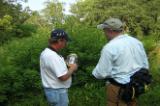What Do We Want To Protect? What Should We Protect?
What Do We Want to Protect?
Prioritization usually focuses on places, but it is important to step back and first prioritize the things you want to protect -- the entities, elements, features, conservation targets, or values. Determining, and then prioritizing, what you want to protect should follow from the mission of your organization and its corresponding goals and objectives. Depending on these organizational goals, the following are examples of protection targets, which can then be prioritized:
- Species (or specific plant and animal populations)
- Natural communities and ecosystems (e.g., representative examples thereof)
- Unusual and interesting geological or geothermal features
- Space for recreation and leisure activities
- Green spaces: undeveloped patches or lots in urban areas that help people connect with nature
- Scenic landscapes and viewsheds
- Ecosystem services, including provisioning, regulating, cultural, and supporting services
- Wetlands, aquifer recharge areas, and other hydrologic features (which provide ecosystem services)
- Historic and cultural features, including historic buildings and trails, sacred sites, and popular gathering places for people
- Property values
Prioritization, then, is best seen as a multi-stage process, beginning with determining what features or values we wish to protect, then refining that list through prioritization within each class, and finally finding the places where we can protect the highest-priority features – and a wide range of all desirable features – efficiently and cost-effectively.
Where Should We Protect?
High-priority sites for conservation are generally characterized by:
- A high concentration of the highest priority features
- A comprehensive mix of high priority features
- A location, such as a habitat corridor that enhances the value of other sites or the viability of species that require large areas or multiple sites across the landscape to maintain viable populations
- A high ratio of benefits to costs (of acquisition, of restoration, of management)
- Minimal conflict with other land uses and relatively little political controversy
Conservation planners now typically make use of computerized site-selection algorithms, which, coupled with GIS, are able to select a network of sites that will meet conservation goals in a highly efficient and cost-effective manner. The basis principles underlying the use of these algorithms -- and of systematic conservation planning in general -- include the following:
- Explicit, quantitative goals
- An assessment of how well goals are met in existing reserves (i.e., a gap analysis)
- Efficiency and cost-effectiveness
- Complementarity – where sites are chosen to complement existing protected areas and other selected sites, rather than duplicating them
- Flexibility – analyzing and presenting various ways to achieve stated goals
- Concern with irreplaceability – the extent to which a site is needed to achieve goals (or contributes to goals)
- Concern not only with representation within reserves, but also persistence – the viability of species and integrity of ecosystems over the long term (i.e., this often requires redundancy in the representation of features, which must be balanced against complementarity), and
- Recognizing the importance of intelligent scheduling – that is, minimizing losses while the reserve network takes shape, since it is usually impossible to protect all areas recognized as important at once.
Scientists have published hundreds of papers applying the principles stated above and making use of sophisticated site-selection algorithms. But how well are these studies being translated into practice? Andrew Knight and coauthors (2008) question the ability of systematic conservation planning, as currently practiced, to provide pragmatic solutions to conservation problems. Indeed, they found that two-thirds of the conservation plans published in the peer-reviewed scientific literature were never implemented. Implementation will require much collaboration between researchers and practitioners, and much greater awareness of the social dimensions of conservation.
In short, conservation planning and prioritization must become more interdisciplinary and participatory. The Malpai Borderlands Group provides one notable example of participatory planning. This grassroots, landowner-driven organization is attempting to implement ecosystem management on nearly one million acres of open space in southeastern Arizona and southwestern New Mexico.
How To Prioritize Sites: A Toolkit
Go Straight to Your State
Learn about conservation and open space in your state.


